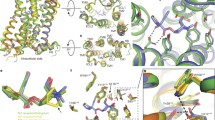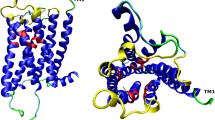Abstract
The ligand binding pocket of many G protein-coupled receptors is thought to be located within the core formed by their seven transmembrane domains (TMDs). Previous results suggested that muscarinic antagonists bind to a pocket located toward the extracellular region of the TMDs, primarily at TMDs 2, 3, 6, and 7. Tyrosine-82 (Y82) is located in TMD2 only one helical turn from the presumed membrane surface of Hm1, whereas a phenylalanine (F124) is found in the equivalent position of the closely related Hm3. In order to determine the contribution of Y82 to Hm1 ligand binding and selectivity versus Hm3, we constructed the point mutation Y82 F of Hm1 and measured binding affinities of various ligands, with 3H-N-methylscopolamine (3H-NMS) as the tracer. The Hm1 wild-type receptor and the Y82F mutant were transfected into human embryonic kidney U293 cells. Whereas the affinities of NMS, carbachol, and atropine were either unchanged (carbachol) or enhanced by less than twofold (atropine and NMS), the affinity of the Hm1-selective piren-zepine was reduced threefold by the Y82 F mutation. These changes parallel affinity differences of Hm1 and Hm3, indicating that the Y82 F mutation affects the binding pocket and that Y82 contributes to the binding selectivity among closely related muscarinic receptors.
Similar content being viewed by others
REFERENCES
M. F. Hibert, S. Trumpp-Kallmeyer, A. Bruinvels, and J. Hoflack. Three-dimensional models of neurotransmitter G-binding protein-coupled receptors. Mol. Pharmacol. 40:8–15 (1991).
J. Lameh, R. I. Cone, S. Maeda, M. Philip, M. Corbani, L. Nádasdi, J. Ramachandran, G. M. Smith, and W. Sadée. Structure and function of G protein coupled receptors. Pharm. Res. 7:1213–1221 (1990).
E. C. Hulme, N. J. M. Birdsall, and N. J. Buckley. Muscarinic receptor subtypes. Annu. Rev. Pharmacol. Toxicol. 30:633–673 (1990).
E. G. Peralta, A. Ashkenazi, J. W. Winslow, D. H. Smith, J. Ramachandran, and D. J. Capon. Distinct primary structures, ligand-binding properties and tissue-specific expression of four human muscarinic acetylcholine receptors. EMBO J. 6:3923–3929 (1987).
T. I. Bonner, A. C. Young, M. R. Brann, and N. J. Buckley. Cloning and expression of the human and rat m5 muscarinic acetylcholine receptor genes. Neuron 1:403–410 (1988).
N. J. Buckley, T. I. Bonner, C. M. Buckley, and M. R. Brann. Antagonist binding properties of five cloned muscarinic receptors expressed in CHO-K1 cells. Mol. Pharmacol. 35:469–476 (1989).
C. D. Strader, I. S. Sigal, R. B. Register, and M. R. Candelore. Identification of residues required for ligand binding to the β-adrenergic receptor. Proc. Natl. Acad. Sci. USA 84:4384–4388 (1987).
S. Suryanarayana, D. A. Daunt, M. von Zastrow, and B. K. Kobilka. A point mutation in the seventh hydrophobic domain of the α2 adrenergic receptor increases its affinity for a family of β receptor antagonists. J. Biol. Chem. 266:15488–15492 (1991).
J. Wess, D. Gdula, and M. R. Brann. Site-directed mutagenesis of the m3 muscarinic receptor: Identification of a series of threonine and tyrosine residues involved in agonist but not antagonist binding. EMBO J. 10:3729–3734 (1991).
C. M. Fraser, C.-D. Wang, D. A. Robinson, J. D. Gocayne, and J. G. Venter. Site-directed mutagenesis of m1 muscarinic acetylcholine receptors: Conserved aspartic acids play important roles in receptor function. Mol. Pharmacol. 36:840–847 (1989).
J. Wess, T. I. Bonner, and M. R. Brann. Chimeric m2/m3 muscarinic receptors: role of carboxyl terminal receptor domains in selectivity of ligand binding and coupling to phosphoinositide hydrolysis. Mol. Pharmacol. 38:872–877 (1990).
S. Maeda, J. Lameh, W. G. Mallet, M. Philip, J. Ramachandran, and W. Sadée. Internalization of the Hm1 muscarinic cholinergic receptor involves the third cytoplasmic loop. FEBS Lett. 269:386–388 (1990).
J. Sambrook, E. F. Fritsch, and F. Maniatis. A Laboratory Manual, 2nd ed., Laboratory Press, Cold Spring Harbor, NY, (1989).
J. Hu and E. E. El-Fakahany. Selectivity of McN-A-343 in stimulating phosphoinositide hydrolysis mediated by m1 muscarinic receptors. Mol. Pharmacol. 38:895–903 (1990).
M. Waelbroeck, M. Tastenoy, J. Camus, and J. Christophe. Binding of selective antagonists to four muscarinic receptors (m1 to m4) in rat forebrain. Mol. Pharmacol. 38:267–273 (1990).
S. K. Fisher. Recognition of muscarinic cholinergic receptors in human SK-N-SH neuroblastoma cells by quaternary and tertiary ligands is dependent upon temperature, cell integrity, and the presence of agonists. Mol. Pharmacol. 33:414–422 (1988).
M. H. Richards. Pharmacology and second messenger interactions of cloned muscarinic receptors. Biochem. Pharmacol. 42:1645–1653 (1991).
R. A. Shapiro, N. M. Scherer, B. A. Habecker, E. M. Subers, and N. M. Nathanson. Isolation, sequence, and functional expression of the mouse m1 muscarinic acetylcholine receptor gene. J. Biol. Chem. 263:18397–18403 (1988).
T. I. Bonner, N. J. Buckley, A. C. Young, and M. R. Brann. Identification of a family of muscarinic acetylcholine receptor genes. Science 237:527–532 (1987).
F. M. Leslie. Methods used for the study of opioid receptors. Pharmacol. Rev. 39:197–249 (1987).
Author information
Authors and Affiliations
Rights and permissions
About this article
Cite this article
Drübbisch, V., Lameh, J., Philip, M. et al. Mapping the Ligand Binding Pocket of the Human Muscarinic Cholinergic Receptor Hml: Contribution of Tyrosine-82. Pharm Res 9, 1644–1647 (1992). https://doi.org/10.1023/A:1015885029612
Issue Date:
DOI: https://doi.org/10.1023/A:1015885029612




